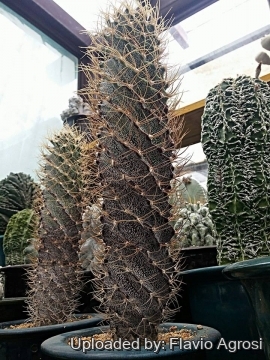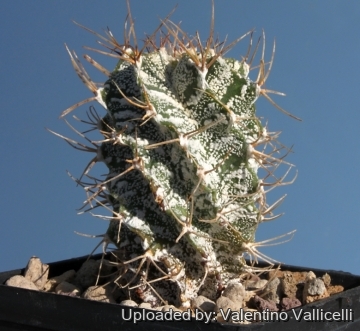Donate now to support the LLIFLE projects.
Your support is critical to our success.
Your support is critical to our success.

Astrophytum ornatum cv. Spiral Photo by: Valentino Vallicelli
Synonyms:
See all synonyms of Astrophytum ornatum
back
Accepted name in llifle Database:Astrophytum ornatum (DC.) F.A.C.Weber in Bois
Dict. Hort. [Bois] 1: 467. 1896
Synonymy: 23
- Astrophytum ornatum (DC.) F.A.C.Weber in Bois
- Astrophytum ornatum f. aurea hort.
- Astrophytum ornatum f. cristatum hort.
- Astrophytum ornatum f. dichotomicum hort.
- Astrophytum ornatum var. glabrescens (F.A.C.Weber) Y.Okomura
- Astrophytum glabrescens F.A.C.Weber
- Astrophytum ornatum var. glabrescens (F.A.C.Weber) Frič
- Astrophytum ornatum f. glabrescens (F.A.C.Weber) Krainz in Krainz
- Astrophytum ornatum f. nuda hort.
- Astrophytum ornatum subvar. glabrescens (F.A.C.Weber) Backeb.
- Astrophytum ornatum var. virens Schütz & Z.Fleisch.
- Echinocactus ornatus var. glabrescens F.A.C.Weber in Bois
- Astrophytum ornatum var. glabrescens f. variegata hort.
- Astrophytum ornatum Metztitlan, Hidalgo, Mexico.
- Astrophytum ornatum var. mirbelii (Lem.) Frič
- Astrophytum ornatum f. mirbelii (Lem.) Krainz in Krainz
- Echinocactus mierbelii Lem.
- Echinocactus ornatus var. mirbelii (Lem.) Croucher
- Echinofossulocactus mirbelii (Lem.) Lawr.
- Astrophytum ornatum var. niveum Schütz & Z.Fleisch.
- Astrophytum ornatum cv. Spiral
- Astrophytum ornatum cv. Fukuryu Hania
- Astrophytum ornatum cv. Hania
- Astrophytum ornatum cv. Kikko
back

Astrophytum ornatum cv. Spiral Photo by: Valentino Vallicelli

Astrophytum ornatum cv. Spiral Photo by: Flavio Agrosi

Astrophytum ornatum cv. Spiral Photo by: Valentino Vallicelli

Astrophytum ornatum cv. Spiral Photo by: Valentino Vallicelli

Astrophytum ornatum cv. Spiral Photo by: Valentino Vallicelli
Send a photo of this plant.
The gallery now contains thousands of pictures, however it is possible to do even more. We are, of course, seeking photos of species not yet shown in the gallery but not only that, we are also looking for better pictures than those already present. Read More...
The gallery now contains thousands of pictures, however it is possible to do even more. We are, of course, seeking photos of species not yet shown in the gallery but not only that, we are also looking for better pictures than those already present. Read More...
| Your Actions | |
|---|---|
| Back to Astrophytum index | |
| Back to Cactaceae index | |
 |
Back to Cacti Encyclopedia index |









